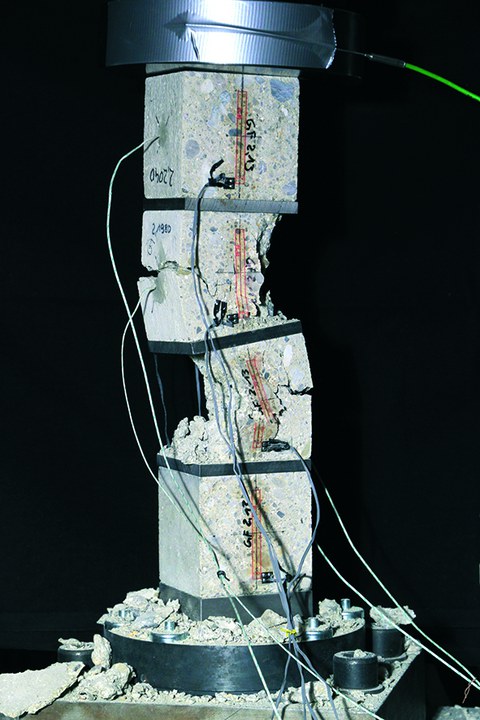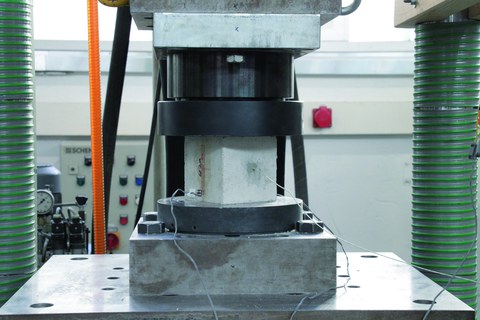Beschleunigung von Betonversuchen mit sehr hohen Lastwechselzahlen
Inhaltsverzeichnis
Projektdaten
| Titel | Title Möglichkeiten zur Beschleunigung von Untersuchungen zur Betonermüdung unter sehr hohen Lastwechselzahlen | Possibilities for accelerating investigations of concrete fatigue under very high numbers of load cycles Förderer | Funding Deutscher Ausschuss für Stahlbeton (DAfStb) Zeitraum | Period 01/2012 – 12/2016 Leiter | Project manager Prof. Dr.-Ing. Dr.-Ing. E.h. Manfred Curbach Bearbeiter | Contributors Dr.-Ing. Torsten Hampel, Dipl.-Ing. (FH) Sabine Wellner, Dipl.-Ing. Robert Schneider |
Das Verhalten von Beton bei einer Anzahl von mehr als 2 Millionen Lastwechseln, wie sie z. B. bei Windenergieanlagen auftreten, ist derzeit noch nicht hinlänglich erforscht. Grund ist unter anderem die lange Dauer eines Einzelversuchs. Innerhalb dieses Forschungsvorhabens werden Möglichkeiten zur Verkürzung der Prüfzeiten untersucht.
Bericht aus dem Jahrbuch 2016
Beton unter sehr hohen Lastwechselzahlen

Belastungsprüfung von vier Würfeln in Reihenschaltung – das Versagen eines Würfels leitete das Versagen der restlichen Proben ein
Für die Bemessung für zyklische Beanspruchungen werden i. d. R. Materialkennwerte, ermittelt nach 2 · 106 Lastwechseln (LW), herangezogen. Für Windenergieanlagen ist dies aber bspw. nicht ausreichend. Hier werden schon in relativ kurzer Zeit deutlich höhere Lastwechselanzahlen N registriert. Dies wirft die Frage nach der Anwendbarkeit bekannter Bemessungswerte auf, denn bisher konnte für Beton keine Dauerfestigkeitsgrenze nachgewiesen werden. Deshalb sind gezielt Versuche für sehr hohe Lastwechselzahlen von N ≥ 107 notwendig, die aber, in der bisher üblichen Art und Weise durchgeführt, extrem zeitaufwendig und kostspielig sind. In einer Machbarkeitsstudie wurden daher in modifizierten Versuchsaufbauten Betonwürfel unter zyklischer Belastung geprüft, um experimentell zu untersuchen, ob die außerordentlich lange Dauer für derartige Versuche reduziert werden kann.
Für die Tests wurden Würfel aus Normalbeton mit einer Kantenlänge von 10 cm hergestellt. In einem ersten Arbeitspaket wurden kraftgesteuerte Druckschwellversuche mit Belastungsfrequenzen von 5, 20 und 30 Hz durchgeführt, um den Einfluss der Frequenz auf die Betonermüdung zu untersuchen. Bei Versuchen mit ca. einer Million Lastwechseln wurde eine solche Frequenzabhängigkeit festgestellt, was sich mit neueren Erkenntnissen anderer Forscher deckt. Eine beliebige Frequenzsteigerung als Mittel zur Verringerung der Versuchsdauer muss folglich ausgeschlossen werden.
Weiterhin wurde untersucht, inwieweit eine Reduzierung der Gesamtversuchsdauer durch eine zeitgleiche Prüfung mehrerer Proben möglich ist. Die Probekörper wurden in Parallel- und in Reihenschaltung mit einer Frequenz von 5 Hz belastet. Während der weggesteuerten Prüfung dreier parallel angeordneter Würfel wurden Lastwechselzahlen von bis zu 3 × 107 ohne vorheriges Versagen einer oder mehrerer Probekörper erreicht. Der Versuchsaufbau mit mehreren Prüfwürfeln in Reihenschaltung erwies sich hingegen als ungeeignet, da beim Versagen eines Würfels aufgrund der nicht ausreichend sensiblen Maschinensteuerung Spannungsspitzen in die verbleibenden Proben eingeleitet wurden.
Begleitend wurde bei verschiedenen Frequenzen bis 30 Hz überprüft, ob sich die Proben infolge der zyklischen Belastung erwärmen. Dies war für den untersuchten Frequenzbereich bei den Würfeln aus Normalbeton nicht der Fall.
Bericht aus dem Jahrbuch 2012
Beschleunigung von Betonermüdungsversuchen

Prüfwürfel im Ermüdungsversuch
Die durch die Energiewende stetig wachsende Anzahl an Windenergieanlagen für die Energiegewinnung in Deutschland erfordert eine wirtschaftliche und dauerhaft sichere Bemessung dieser Anlagen gegen ein Ermüdungsversagen. Windenergieanlagen sind stark dynamisch beanspruchte Bauwerke mit bis zu 109 Lastwechseln bei einer geplanten Lebensdauer von 20 bis 25 Jahren.
Das Verhalten von Beton bei einer Anzahl von mehr als 2 Millionen Lastwechseln ist aber derzeit noch nicht hinlänglich erforscht. Hauptgrund ist, dass Belastungsversuche im Bereich sehr hoher Lastwechselzahlen ≥ 107 in der bisher durchgeführten Form äußerst zeitaufwendig sind. Deshalb werden in dem vom Deutschen Ausschuss für Stahlbeton e. V. (DAfStb) geförderten Forschungsprojekt verschiedene Möglichkeiten im Hinblick auf eine Verkürzung der Prüfzeit von Betonprobekörpern bei sehr hohen Lastwechselzahlen untersucht.
Das aktuelle Forschungsvorhaben gliedert sich in drei Arbeitspakete. Im derzeit in Bearbeitung befindlichen Arbeitspaket 1 werden an 10er Würfeln aus Beton C 30/37 Druckversuche unter einer Schwellbelastung mit 106 Lastwechseln bei Prüffrequenzen von 5, 10 und 50 Hz durchgeführt. Durch den Einsatz von Temperatursensoren im Inneren des Würfels werden zudem Erkenntnisse über den Temperaturverlauf während der dynamischen Beanspruchung gewonnen, um abzuklären, ob sich die Probekörper während des Versuchs erwärmen, was im jungen Betonalter möglicherweise eine Festigkeitssteigerung bewirken könnte.
Die Prüfung der Probekörper erfolgt durch eine sinusförmige, kraftgesteuerte Druckschwellbelastung. Die Höhe der zyklischen Schwellbelastung wurde anhand der zuvor durchgeführten Druckversuche unter ruhender Belastung bestimmt. Das Schwingspiel wurde, ausgehend vom Mittelwert der Bruchfestigkeit, mit einer Oberlast von 80 % sowie einer Unterlast von 60 % festgelegt. Die Schwingungsamplitude beträgt somit 20 %.
Während der dynamischen Beanspruchung der Prüfkörper wurde bisher nur ein geringer Anstieg der Temperatur im Inneren des Würfels festgestellt. Ob die Veränderung des Temperaturverhältnisses von innen zu außen jedoch ausschließlich aus der Druckschwellbeanspruchung resultiert, kann bisher noch nicht vollständig belegt werden.
